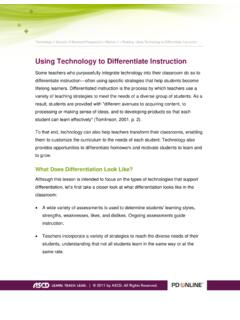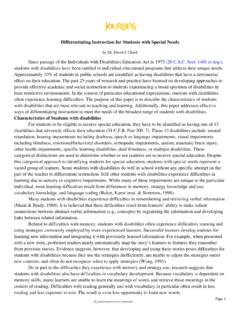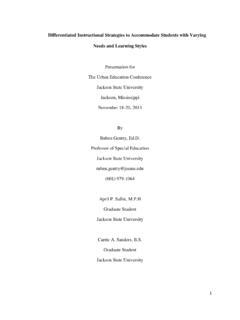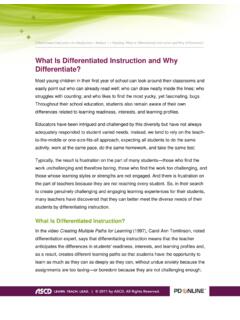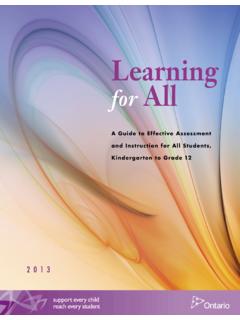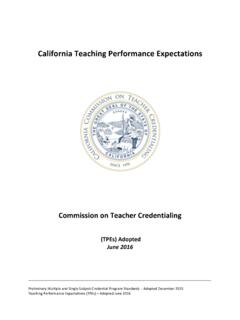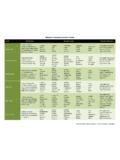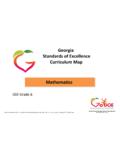Transcription of Differentiating Instruction for Gifted Learners
1 Differentiating Instruction for Gifted Learners : A Resource for Classroom Teachers Deirdre Kelly, Lake Sybelia Elementary September, 2011 Page 1 Differentiation .. a teacher s response to a learner s needs. (Tomlinson) .. customizing Instruction so every individual experiences continuous learning. (Kingore) Guiding Principles of Differentiation: - Respectful work for all Learners . - A,B,C & 1, 2, 3: Teachers can differentiate content, process, & product, according to a student s readiness, interest, & learning style. - Assessment & Instruction are inseparable. - Assessment before, during, & after Instruction is critical for making appropriate modifications for Gifted Learners . - Focus on the essentials. - Modification of content, process, and products. o Content = what is taught and how students access information. o Process = how a student makes sense of or comes to understand the information, ideas, and skills that are that the center of the lesson.
2 O Product = assessment or demonstration of what students have come to understand & know. - Replacement tasks should be respectful works that serve a purpose (not busy work). Recognizing the Needs of Gifted Learners : Gifted Learners are often characterized .. their ability to process information quickly.. their ability to make connections within and among disciplines.. the pace at which they learn.. the depth of their understanding.. the variety of interests that they hold. Gifted Learners need differentiated content, process, product, & affectives. Differentiating Instruction for Gifted Learners What it takes to teach Gifted Learners begins with the premise that each child should come to school to stretch and grow daily. It includes the expectation that the measure of progress and growth is competition with oneself rather than competition against others. It resides in the notion that educators understand key concepts, principles and skills of subject domains, and present those in ways that cause highly able students to wonder and grasp, and extend their reach.
3 And it envisions schooling as an escalator on which students continually progress, rather than a series of stairs, with landings on which advanced Learners consistently wait. - National Association of Gifted Children Differentiating Instruction for Gifted Learners : A Resource for Classroom Teachers Deirdre Kelly, Lake Sybelia Elementary September, 2011 Page 2 Assessment & Mastery: When all kids have the same answers, I have no clue what they really know. Kingore Keep in mind: Mastery does not equal perfection. Ideas for Assessing Readiness: Individuals: pretests for volunteers, most difficult questions/items first, exit tickets Whole Group: individual response boards, Four Corners, Topic Talk, Name Cards/sticks Pretests: Don t reinvent the wheel end of chapter/skill tests work. Set a goal for mastery to qualify for Compacting (usually 80-85%) to be verified with admin.
4 Plan for grading issues. How to teachers make it all work? ~ Start small - but start somewhere! Differentiation for small blocks of time. Use anchor activities. ~ Grow slowly but grow! Try creating one differentiated lesson per unit, one project per semester, etc. ~ Give structured choices more often. ~ Step back and reflect. ~ Talk w/ students regularly to get input. ~ Give thoughtful directions. ~ Work together with colleagues. ~ Bring principals and parents on board. ~ Continue to empower students (don t do things for them that they can do for themselves) Student Management: Remember, student choice is a powerful motivator. The Three Magic Rules : (Winebrenner, 2001) 1. Don t bother anyone else while you re working. 2. Don t call attention to yourself or the fact that you re doing something different it s no big deal. 3. Work on activities you ve chosen or been assigned.
5 Effective teaching is responsive teaching. - Tomlinson Differentiating Instruction for Gifted Learners : A Resource for Classroom Teachers Deirdre Kelly, Lake Sybelia Elementary September, 2011 Page 3 Pace Delivery -- Product -- Process (Depth & Breadth) Change the Pace: pre-testing Curriculum Compacting tiered activities most difficult first alternate assignments learning contracts Independent Study Learning Centers Change the Delivery/Content: mini-lessons different resources Curriculum Compacting Independent Study open-ended questions teacher conferences reading journals previewing resources Change the Product: choice boards Tic Tack Toe menus RAFT (role, audience, format, topic) game show menu student choice options game creation technology-based products: websites, Wikis podcasts, movie making Change the Process - Add Depth.
6 Tiered activities open-ended activities higher-level questions curriculum ladders student experts increase complexity decrease structure Change the Process - Add Breadth: Tic Tack Toe menus interdisciplinary units orbital studies simulations your own idea options choice boards RAFT assignments interest centers case studies role plays When I differentiate Instruction for Gifted Learners , what should I be doing? Differentiating Instruction for Gifted Learners : A Resource for Classroom Teachers Deirdre Kelly, Lake Sybelia Elementary September, 2011 Page 4 Gifted Differentiation: Definitions Anchor Activities Provide student with relevant, meaningful activities that can be completed independently. Level to meet different student needs. Used as a management tool for early finishers and small group Instruction . Activity Menus Integrate student choice, different levels of thinking, & multiple intelligence.
7 Menu might focus on a concept/topic or can cross subject areas. Example: Tick Tack Toe Flexible Grouping Gifted students are not necessarily Gifted in everything. Flexible grouping allows for students to move in and out of groups based on need, ability, interest, etc. Peer Teaching Use sparingly. Guiding principles: Every student deserves the opportunity to work with intellectual peers on appropriately challenging tasks. Gifted students are not always the best teachers Peer teaching is most appropriate for students who have just gotten a concept not for a student who has already mastered it. Cubing Allows you to guide student thinking in multiple directions and to differentiate process and product for students of varying abilities. Don t have time? Consider using think dots correlate activities and questions with the number of dots on each side of a regular die.
8 Curriculum Compacting Great way of finding time for enrichment and extension. Guided by demonstration of mastery. Allows students to substitute projects and activities that more appropriately meet their learning needs. Pre-asses to find out what the student already knows and what they still need to learn. Document to show mastery. Teach remaining skills in whole/small group or independently. Provide a replacement activity: extension activity, learning centers, independent projects, subject acceleration, mentorships. Compacting is especially useful for skill-based areas (math, spelling, grammar, reading strategies, etc.). Grades should come from pre-assessment (grade level work). Use a learning contract to provide structure. ~ Learning contracts usually feature: 1. A list of content covered in a unit with indicators identifying concepts not mastered during pretest.
9 2. Student joins class for direct Instruction during those lessons. 3. Extension options (include student ideas) Conditions. 5. Signatures at bottom. Independent Study Use connections to real world problems, student interaction, & depth of content. Topic may be related to class subject or interest-based. Use a pre-made form to guide project development. Involve media specialist in resource selection. Note: Be aware of work habits: time management, organizational skills, research, etc. Not all Gifted kids are good independent workers. Multilevel or Tiered Activities/Lessons open-ended activities allow students to naturally work at various ability levels. Tiered activities have two or more levels of difficulty/complexity in regard to content, process, and/or product. Levels assigned based on data from pretesting. Students must have understanding that not everyone needs the same thing.
10 Each tier must have motivating and challenging activities that are appropriate for student needs. Samples: paper chain, story map, timeline, Top 10 List , I am character traits, experiments, etc. Learning Centers Centers may be permanent or temporary (country of the month, author study, art technique, reading topic. Share with other teachers throughout the year (saves time and money). Making centers work task card w/ brief, clear directions. Center logs, assignment/choice boards. Accelerated Learning case by case. Prior approval. Attend class w/ next grade level. Most effective strategy for Gifted Learners . Differentiating Instruction for Gifted Learners : A Resource for Classroom Teachers Deirdre Kelly, Lake Sybelia Elementary September, 2011 Page 5 Readiness-Based Adjustments Abstract Complex Transformational Multi-facets Great Leaps Open Independence Slow & Deep Readiness-based adjustments can be created by teachers offering students a range of learning tasks developed along one or more of the following continua: Concrete to abstract.)




